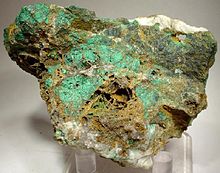Cornwallite
Copper arsenate mineral
(repeating unit)(same H-M symbol)
c = 4.60 Å; β = 92.22°; Z = 2
Cornwallite is an uncommon copper arsenate mineral with formula Cu5(AsO4)2(OH)4. It forms a series with the phosphate pseudomalachite and is a dimorph of the triclinic cornubite. It is a green monoclinic mineral which forms as radial to fibrous encrustations.

Discovery and occurrence
It was first described in 1846, for an occurrence in Wheal Gorland, St Day United Mines of the St Day District, Cornwall, England.[4] It occurs as secondary mineral in the oxidized zone of copper sulfide deposits. Associated minerals include olivenite, cornubite, arthurite, clinoclase, chalcophyllite, strashimirite, lavendulan, tyrolite, spangolite, austinite, conichalcite, brochantite, azurite and malachite.[3]
See also
- Kernowite, another mineral named after Cornwall
References
- ^ Warr, L.N. (2021). "IMA–CNMNC approved mineral symbols". Mineralogical Magazine. 85 (3): 291–320. Bibcode:2021MinM...85..291W. doi:10.1180/mgm.2021.43. S2CID 235729616.
- ^ Mineralienatlas
- ^ a b Cornwallite in the Handbook of Mineralogy
- ^ a b Cornwallite on Mindat.org
- ^ Cornwallite data on Webmineral











